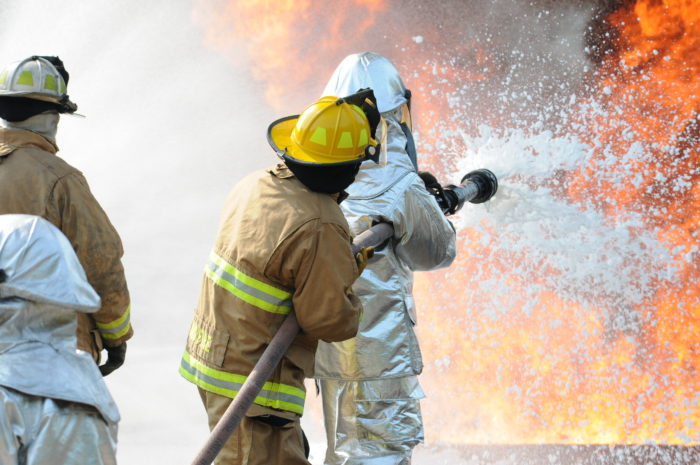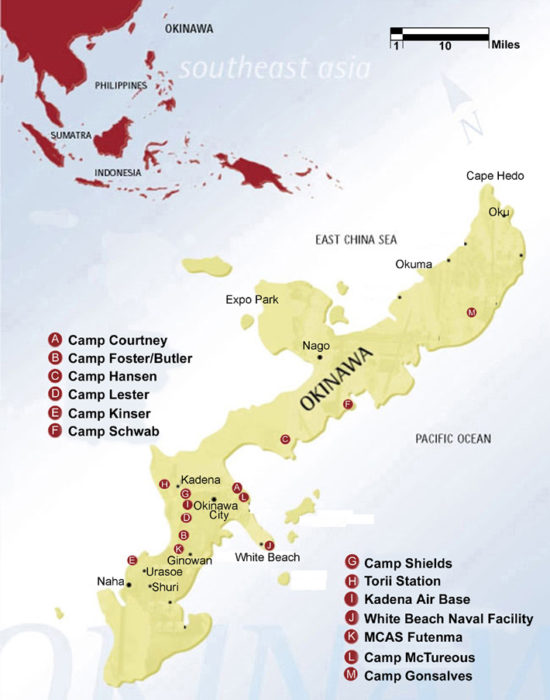The Japanese island hosting U.S. military bases and training sites is a forerunner in exposing the contamination, writes Pat Elder.
Fire-Fighting Exercises Spread ‘Forever Chemicals’
By Pat Elder
World BEYOND War
 Contaminants are being detected in water samplings in communities adjacent to U.S. military installations around the world. One forerunning example—publicized more than five years ago—is the Japanese island of Okinawa, which hosts 32 U.S. bases and 48 training sites.
Contaminants are being detected in water samplings in communities adjacent to U.S. military installations around the world. One forerunning example—publicized more than five years ago—is the Japanese island of Okinawa, which hosts 32 U.S. bases and 48 training sites.
In 2013, The Japan Times published an exposé about the high concentrations of toxins generically known as per- and polyfluoroalkyl substances, or PFAS, in the drinking water in Okinawa communities adjacent to Kadena Air Base and the Marine Corps Air Station Futenma.
The chemicals are found in the fire-fighting foam used in routine fire-training exercises on these bases and have been found in groundwater samplings. The Military Times in June ran an article about several women who have suffered miscarriages on military bases and have begun wondering if they were tied to something in the water.
The National Center for Environmental Health and the Agency for Toxic Substances and Disease Registry both offer guidance about the possible health risks of PFAS exposure. The Environmental Protection Agency, while declining to regulate the chemicals, offers similar advice.
These agencies say the risks of high exposure include higher cholesterol levels; a decrease in how well the body responds to vaccines; heightened risk of thyroid disease; decreased fertility in women; increased risks to pregnant women that include high blood pressure or pre-eclampsia.
The Intercept reported on a small study that found certain PFAS correlated to lower sperm counts and other problems in males.
The Agency for Toxic Substances and Disease Registry points out that a large number of animal studies show that polydiacetylenes, or PDAs, can cause damage to the liver and the immune system.
Two other types of PFAS—perfluorooctane sulfonate, or PFOS, and perfluorooctanoic acid, or PFOA—have caused birth defects, delayed development and newborn deaths in lab animals. Studies in animals have shown that PFOA and PFOS can cause cancer in the liver, testes, pancreas and thyroid. Of course, humans and animals react differently to PFAS.
Michigan Scientists Flag Risks
A panel of scientists in Michigan who are grappling with numerous municipal water systems contaminated with PFAS concurs with the ATSDR’s assessment “with regard to associations of PFAS exposure to alterations of thyroid function, high cholesterol, ulcerative colitis, testicular cancer, kidney cancer, pregnancy-induced hypertension, and elevated liver enzymes,” according to a report by the trade magazine Environmental Newsstand (which operates behind a paywall).
Public concern about the environmental threats of these chemicals, spans the globe, from New Zealand, to Korea, to Germany.
The U.S.-Japan agreement on the Okinawa bases does not allow for Japanese officials to gain access to the bases to investigate the source of the contamination. “Within the facilities and areas, the United States may take all the measures necessary for their establishment, operation, safeguarding and control,” reads the Status of Forces Agreement between the U.S. and Japan.
Japan’s SOFA differs from those in force in European nations such as Germany, where local authorities are allowed to enter bases. According to Japan’s SOFA, Japanese officials may not conduct investigations without U.S. consent. In Germany they can.
According to Jon Mitchell, a British author who wrote the 2013 article for Japan Times, when the Okinawa Defense Bureau approached U.S. military officials in February 2017 to discuss drinking water being contaminated by the aqueous fire-fighting foam, American military officials rejected the meeting, saying the PFAS-laden foam is not a regulated substance.
They’re right. The EPA continues to allow their use.
It’s possible to speculate as to why that is: Reining in all 3,000 PFAS and admitting their destructive impact might unleash a flood of lawsuits against manufacturers and the military and worldwide unrest. The military might have good reason to simply hope the issue fades away.
‘Forever Chemicals’
But it won’t. After all, these compounds are known as “forever chemicals” because they don’t break down.
Michigan authorities, for example, recently banned eating deer caught close to Wurtsmuth Air Base. The base was closed 25 years ago but the streams are still dangerously contaminated.
Amid growing public concern about the chemicals, the EPA is coming under pressure. On the heels of a news report saying the EPA refuses to regulate PFAS and PFOS, the agency on Jan. 30 said it was still crafting an action plan. “Despite what is being reported, EPA has not finalized or publicly issued its PFAS management plan, and any information that speculates what is included in the plan is premature,” said David Ross, assistant administrator of the Office of Water.
As long as the EPA refuses to regulate these substances U.S. military officials can continue shrugging off the release of the chemicals into neighboring communities from Belgium to Korea; Honduras to Japan.

U.S. Air Force and New Jersey state fire fighters battle a simulated aircraft fire. (U.S. Air National Guard photo by Airman 1st Class Amber Powell)
Currently, the EPA has set a voluntary limit of 70 parts per trillion, or ppt, for PFAS, while the developing consensus in the scientific community—the one that legitimately aims to protect public health—says that 70 ppt is exceedingly high.
As of August 2017 the DOD had tested 2,668 wells worldwide for PFAS and found 61 percent of them were above70 ppt.
Amid chemical industry pressure, in early 2018, Scott Pruitt’s EPA and the White House frantically sought to block publication of a federal health study on PFAS, after one Trump administration aide warned it would cause a “public relations nightmare.”
The study was finally released in June, when the Agency for Toxic Substances and Disease Registry significantly lowered the lifetime drinking water levels to 11 ppt for PFOA and 7 for PFOS.
Still, this voluntary measure is likely to be dangerous for human health, according to leading American health scholars. In 2016, Philippe Grandjean of the Harvard T.H. Chan School of Public Health, and Richard Clapp of the University of Massachusetts at Lowell, calculated that an approximate safe dose of PFOS and PFOA in drinking water is 1 ppt.
Municipal water systems in Okinawa have been shown to contain more than a hundred times that level, while ground water is contaminated at a level a thousand times higher. The contamination is not confined to Okinawa. For instance, groundwater at China Lake, Calif., was recently tested at 8 million ppt. The Department of Defense reports other high levels at active and former bases through the U.S., including those in New York, Alaska and Florida.
Although few in America who live adjacent to military bases are aware of the contamination, the situation is different in Okinawa, where researchers and activists have been sounding the alarm.
Data on Okinawa Contamination
The Chatan water plant supplies water to a half dozen villages near U.S. Marine Corps Air Station Futenma. In 2015, the water at Chatan measured up to 120 ppt for PFAS. The Dakujakugawa River that runs through the base was found to contain 1,379 ppt of PFAS. Ground water tests in the area ranged from 83 ppt to 290 ppt.

Firefighters at Tyndall Air Force Base in Florida train to fight interior aircraft fires.
(U.S. Air Force photo/Eddie Green)
According to a Marine Corps document obtained by British journalist Jon Mitchell in February 2016, PFOS at a concentration of 27,000 parts per trillion and PFOA at a concentration of 1,800 parts per trillion were detected when investigating the sewage in the firefighting training area on U.S. Marine Corps Air Station Futenma.
The Okinawan Prefectural Government has identified 15 rivers and water treatment facilities with dangerous levels of PFOS and PFOA contamination. In November 2018, Okinawa officials reported that 2,000 ppt of the chemicals were detected at the Chunnag? Spring Water Site (Wakimizu Chunnag?) in Kiyuna, Ginowan City.
In 2015, in response to a freedom-of-information request, the Pentagon released records detailing high levels of contamination on Okinawa’s Camp Kinser Marine Corps Base land that was scheduled for return to civilian use. Those records showed high concentrations of: chlordane; DDT; malathion; dioxin; polychlorinated biphenyls, or PCBs;
lead and cadmium. Massive quantities of neutralized cyanide compounds, inorganic acids, alkalis, and 12.5 tons of ferric chloride were buried or “flushed” on the base. The U.S. has also left behind arsenic, depleted uranium, nerve agents and hexavalent chromium.
Massive amounts of pesticides were buried at Camp Hansen, a U.S. Marine base in the town of Kin.
Pat Elder is the director of the National Coalition to Protect Student Privacy. He serves on the Coordinating Committee of World BEYOND War. Special thanks to Joseph Essertier, associate professor, Nagoya Institute of Technology and coordinator of Japan for a World BEYOND War. Some of the findings in this article are based on the research of Jon Mitchell, a British journalist and author based in Japan and of Masami Kawamura of the Okinawa-based Informed-Public Project, a research organization focusing on environmental issues.


“According to Jon Mitchell, a British author who wrote the 2013 article for Japan Times, when the Okinawa Defense Bureau approached U.S. military officials in February 2017 to discuss drinking water being contaminated by the aqueous fire-fighting foam, American military officials rejected the meeting, saying the PFAS-laden foam is not a regulated substance.
“They’re right. The EPA continues to allow their use.”
That’s the EPA that’s part of the lawless USA.
It’s hard to even summon words to describe the level of disgust I feel for this criminal empire and its military machine. This is what happens when you allow a small cabal of crooked capitalists supported by their handpicked paid off politicians to have their way. A poisoned planet with no way to reverse the damage.
I suffer from testicle, prostate, and renal toxicity problems. My thyroid has stopped working and my pituitary about 4 years ago but have since straightened out along with potassium deficiency. I was at Camp Lejeune in the 80’s and at Camp Hansen, guess I got a double dose .. great
It is fact that man has detrimentally harmed our earth and atmosphere through the use of toxic chemicals. There appears not to be no remorse for having placed all living beings and things on this planet, but as well, no interest in reversing the horrific carbon footprint that has imperiled our suffering planet. This is hideous!
NATO = Poison! Poisonous firefighting foam, GMOs, chlorinated chicken, Glyphosate, and fracking oil being force fed into Europe via the TTIP and military alliance.
When you’re told AFFF is just soap, you tend not to treat it like it’s dangerous. That’s all there is to it people. It’s sad but those are the facts. Now a lot older and a little wiser in the fire service, we find out the real story. There’s part of me that thinks it was just an oversight and no harm was intended. Then you find out that the military knew of the dangers back in the 1970’s. So they are responsible for keeping this under the radar so long.
This is astoundingly bad news for anyone who cares about health and the environment. This is more proof the military is not only wasteful, but incredibly irresponsible. And yet they still want to turn this base over to civilian use?
No one can defend this aspect of the military and the toxic trail it leaves behind. The US can still pretend to be the shining light on the hill as their military leaves toxins that will not break down in the environment all over the world, polluting important water resources people need to survive. With 700 to 800 bases around the world just imagine the trail of environmental destruction. Even if fire fighting training is not conducted all over the world in these bases (and I’m sure its not), the other items speak volumes. That is: depleted uranium,dirty bomb testing, nerve agents, more mystery chemicals, and the list goes on. While people are distracted by bad, bad, evil chlorine in Syria – most likely brought in by the white helmets and British SS- the US has done far worse destruction with chemical and nuclear weapons than any other country in the world, all for what is mistakingly called “defense”.
The US hasn’t even destroyed their chemical stockpile agreed upon with Russia years ago, but Russia has done their part of the contract. Since the military is not a ‘democracy’ by any stretch of that imaginary word they don’t have to answer to anyone do they? It either becomes classified or flat out ignored. This is the excrement of this modern empire so admired in DC by both parties. There is no way to sugar-coat this aspect of our DoD. It is sick, and making the world sicker by their very existence. No other ‘empire’ had the chemical means to pollute the world as the US does, and they won’t stop.
Absolutely. Complete and utter irresponsibility, a shrug the shoulders attitude toward the occupied peoples as well as, clearly, their own working members (after all they also, presumably drink the water, shower in it and so on).
Frankly, from my perspective, there should be no “standing” military in any guise, beyond, say, the National Guard which is part-time and (should be) purely defensive. And without this military empire (it is an empire in and of itself) there would be no further pollution and no further destruction of other peoples countries, lives and ways of life.
As you point out, while Russia has kept to the chemical weapons agreement, the US has not. Indeed it has used banned weapons recently (chemical and cluster), weapons it supposedly signed onto the banning of. As hypocritically, while it insists on other countries neither developing or having these or nuclear weapons, indeed requires them (like NK) to give them all up and their being inspected by “neutral” outside experts, the US does not, ever, do anything remotely similar.
AnneR, a good reminder from you, and not off-topic.
Re: your last paragraph where hypocracy rules in the DoD (shockingly) you make the remark “ While (the US) insists on other countries neither developing or having these nuclear weapons” it brings to mind the situation in Israel and Dimona. I can’t remember any article referencing the inspection of Dimona by any nuclear agency, the Pentagon, nor agreeing to the NPT. Can you? Every other country (like NZ) needs to be on bended knee, except…….
Re: clean up. I wonder if it as simple as the 30-40 year Lifers in the military just wanting bigger toys they don’t have to pay for. As far as the allocation of funds, take the 22 Billion+ on the ‘stealth pig Zumwalt destroyer’ (the ammo can’t fit the guns etc) program that isn’t stealthy, can’t float or turn, and has to be towed because the engines get flushed with sea water, and the $500 million spent on the rail gun, which Adm John Richardson recently said the rail gun should be a case study example in “how innovation maybe shouldn’t happen”.
So, the rail gun toy, the Zumwalt destroyer (so far only capable of destroying a budget) and the not-often-flying-F35 debacle, if properly managed, could easily pay for the cleanup of these noxious sites around the world with money to spare. And they do have the manpower to do this too I might add, so it won’t create unemployment.
Sorry, I didn’t mean to post this twice. There’s no option to delete it.
It’s not like the United States military is the world’s largest source of pollution, is it?
We are the world
We are the toxins
We are the ones who make a darker day, so let’s start polluting
There’s a choice we’re making
We’re killing our own lives
It’s true we’ll make an end of days, just you and me
Chris
I think the military is a huge polluter and major contributor to climate change, and other toxic strikes to life on earth.
What is the point of a 21 gun salute? Not a healthy tradition, in my opinion.
It is – https://www-ecowatch-com.cdn.ampproject.org/v/s/www.ecowatch.com/military-largest-polluter-2408760609.amp.html?amp_js_v=a2&_gsa=1&usqp=mq331AQCCAE%3D#referrer=https%3A%2F%2Fwww.google.com&_tf=From%20%251%24s&share=https%3A%2F%2Fwww.ecowatch.com%2Fmilitary-largest-polluter-2408760609.html
This tragic story reminds me of another tragic poisoning of people at the hands of “military decision making”.
From NYT article 8/14/88:
“Elmo R. Zumwalt 3d, son of the admiral who ordered the spraying of Agent Orange in Vietnam, and who was exposed to the defoliant himself, died of cancer today at his home. He was 42 years old.”
Unintended consequences, once again, with so many parties to share the blame for this horror.
If it’s truly a “forever chemical”, i.e. it never breaks down, then surely the allowable limit is 0 ppanything. There’s no such thing as a [fillintheblank] fairy that’s going to come and make all this stuff just magically go away.
Of all the irresponsible, unaccountable organizations in our modern capitalist world, the military rates very high on that list. Is the preoccupation with killing other human beings a factor? A few more murdered, what’s the difference….?
Exactly.